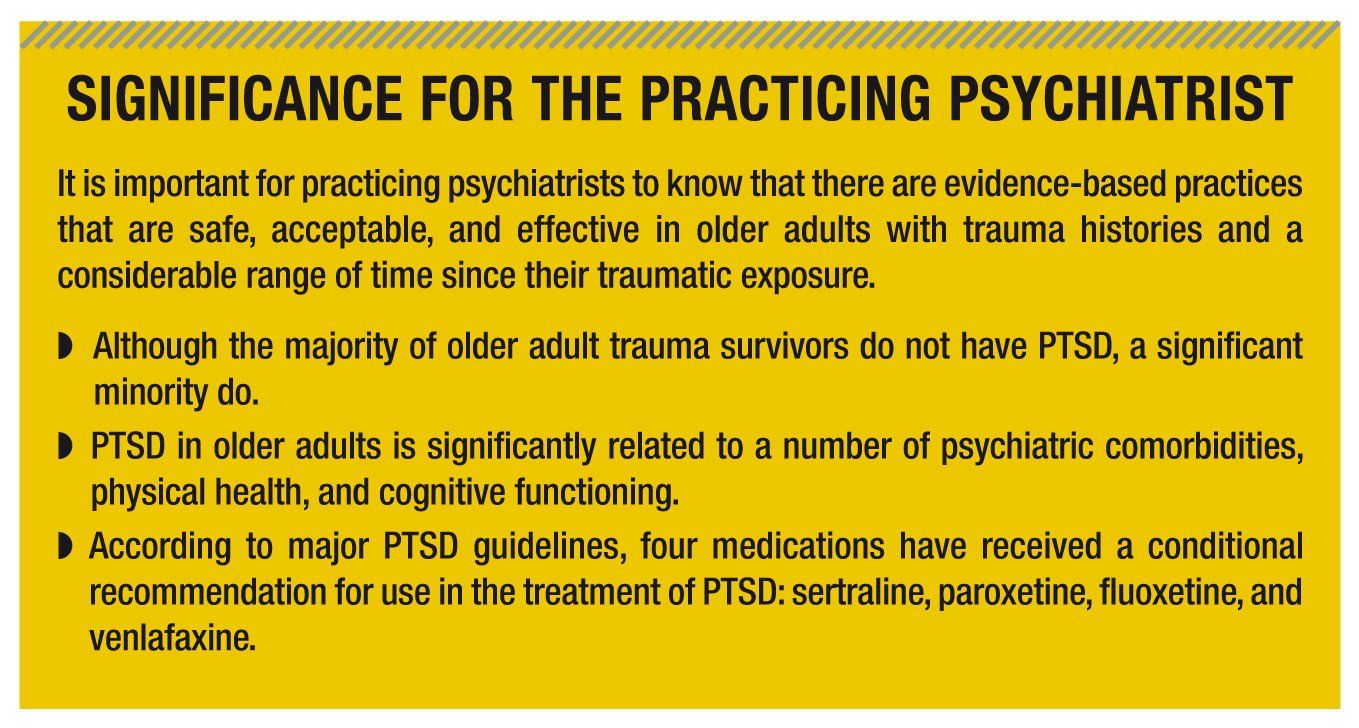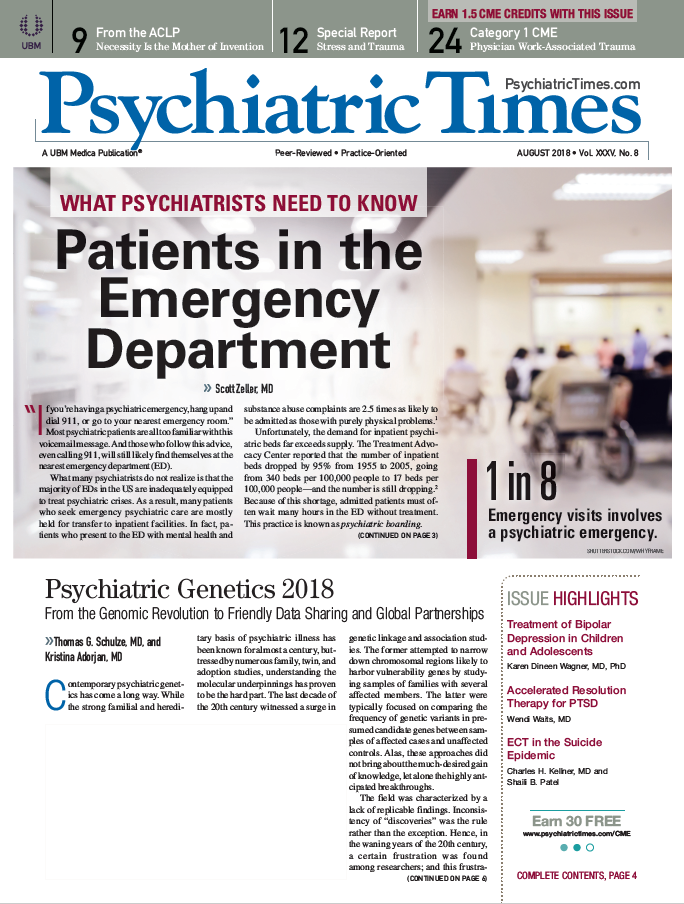Publication
Article
Psychiatric Times
PTSD in Late Life
Author(s):
Trauma may be a hidden variable in the lives of older adults, impacting them in ways they may not recognize or be willing to admit.
SIGNIFICANCE FOR THE PRACTICING PSYCHIATRIST

Special Issues
Relatively little is known about trauma and PTSD in older adults in comparison to young and middle-aged adults. In fact, up until the past decade, large-scale epidemiological studies examining the prevalence and impact of trauma did not include sufficient numbers of older adults to adequately examine the effects of age. More recent investigations of community-dwelling adults in the US generally indicate that older adults report fewer traumatic events and related psychiatric symptoms than younger individuals. For example, the prevalence of past-year PTSD was significantly higher for younger (4.3%) and middle-aged (5.2%) adults compared with older adults (2.6%) and so were the odds of comorbid psychiatric disorders.1
However, some have surmised that trauma is a hidden variable in the lives of older adults, impacting them in ways they may not recognize or be willing to admit.2 For instance, older adults may have experienced trauma but do not recognize the potential deleterious health effects or do not disclose these experiences to health care providers. Moreover, health care providers may not recognize trauma and related distress in older adults. This lack of recognition or misattribution of trauma-related symptoms can have negative implications for treatment and recovery, including the design of ineffective treatment plans and administration of incongruous psychotherapy, medication, or other medical intervention.
Prevalence of PTSD in older adults
Although the majority of older adult trauma survivors are not affected with PTSD, those that are or show other related distress are of note. For example, in a large nationally representative prospective cohort study with over 2000 US veterans aged 60 and older, a total of 3.5% met screening criteria for current PTSD-many had significantly increased odds of mood, anxiety, and substance use disorders, suicidal ideation, and suicide attempts.3 Most of the veterans in this cohort were resilient, having few to no psychiatric symptoms. They exhibited higher emotional stability, social connectedness, protective psychosocial characteristics, and positive perceptions of the military’s effect on one’s life.
Trauma and PTSD in the older adult population has also been linked to physical health problems, disabilities, and poorer cognitive functioning. In a large, longitudinal study of older community-residing male veterans, combat exposure and PTSD were both negatively related to self-reported physical health and to physician-diagnosed medical conditions that included arterial, gastrointestinal, and musculoskeletal disorders.4 Data from three aggregated nationally representative samples show that older adults with chronic PTSD were three times more likely to have any disability than were those with no PTSD.5 And, in a sample of over 10,000 veterans aged 65 and older, those with PTSD had almost twice the odds of having a diagnosis of dementia.6
There are few longitudinal studies of PTSD across the lifespan but in general it appears that if symptoms occur early in life and are untreated, they often wax and wane across the lifespan. As one ages and transitions into older adulthood, there is typically an increased likelihood for loss and the impact of such events can exacerbate symptoms. Furthermore, as one transitions into older adulthood, there is an increased risk for medical illness, decrements in functional status, bereavement, retirement, changes in social and familial roles, diminishing of control, and more time for reflection-all of which can deepen the impact of PTSD.
Assessment and treatment of PTSD in older adults
Health care providers may not recognize physical or mental health symptoms as the result of traumatic events or may be unsure of how to provide assessment and treatment of trauma and PTSD to an older population. Older adults may express mental health difficulties as somatic concerns or be reluctant to acknowledge such problems because of perceived stigma.7 It is also important to consider that older adults who experienced a trauma early in life may not have been encouraged by their family or society to discuss it.
Older adults may not be able to readily identify psychological problems given the lack of agreed upon or well-established terminology to describe traumatic experiences and the impact of those experiences during their formative years. Although most older trauma survivors do not develop PTSD, partial or subthreshold PTSD seems to be an issue worthy of assessment and clinical attention.8
There is a need to utilize effective evidence-based practices which are safe, acceptable, and appear to be effective in older adults with trauma histories and a considerable range of time since traumas. Three cognitive-behavioral therapies stand out in particular: prolonged exposure, cognitive processing therapy, and eye movement desensitization and reprocessing.9-11 All three are trauma-focused models, in which patients address trauma through either detailed enumeration or a challenge of cognitions related to the traumatic event. (For a detailed description of prolonged exposure therapy for older adult trauma survivors, see Cook and Dinnen12 and Cook et al.13)
Although most psychosocial interventions are similar to those used in PTSD treatment with younger adults (eg, education about symptoms, enhancement of social support, coping tools to more effectively manage symptoms), some specific concerns should be considered when working with older traumatized adults. First, it is crucial to consider older adults’ cognitive abilities to help determine the most effective psychotherapeutic approach. For example, older trauma survivors with cognitive impairment (such as non-reversible dementia) may have lowered thresholds for responses to trauma cues or triggers. Older adults with moderate to severe cognitive impairments may not be able to fully benefit from traditional learning-based therapies.
Since older adults may have sensory problems and slower learning rates, repetition is important in the psychotherapy process. Psychoeducation, trauma-processing therapies, or distress management skills can be presented in both verbal and visual modalities (ie, on chalk boards and hand-outs), in order to help them encode and retain information. Psychotherapy with traumatized older adults may also necessitate a few clearly outlined goals and a more active or task-focused approach, with goals of treatment highlighted and reinforced. Age-related changes can constitute stressors that exacerbate PTSD (eg, ill health, retirement, widowhood).
Awareness of and adjustment to these changes may help to reduce trauma-related distress. Providing psychotherapy to older adults often requires flexibility in scheduling, location, and collaboration. Older adults may have reduced mobility, competing health care appointments, and responsibilities to care for relatives, all of which may affect attendance and engagement in face-to-face psychotherapy session. Thus, brief, occasional telephone sessions may have to be made at times to maintain therapeutic contact and continuity. Because older adults often have concurrent health problems, consultation and coordination with other health service providers is often essential. Detailed discussions of further unique considerations in providing psychotherapy with older adults can be found in the Guidelines for Psychological Practice With Older Adults.14
There are few effective pharmacotherapy options for the treatment of PTSD symptoms in older adults. Four medications received a conditional recommendation for use in the treatment of PTSD: sertraline, paroxetine, fluoxetine, and venlafaxine. It is essential to consider age-related adverse effects of medications, such as greater sensitivity, different metabolic rates of medications, and the impact of polypharmacy on treatment adherence.
Conclusion
The scientific knowledge base and understanding of trauma in older adults has grown enormously over the past two decades, however, there is still a great need for additional research with this neglected population. Most of the literature on traumatized older adults has centered on men, particularly veterans or former prisoners of war, and on white citizens of western nations. More investigation is needed to determine if these findings can be generalized to a broader older adult population.
Disclosures:
Dr McCarthy is a Consultant, Executive Division, VA Department of Veterans Affairs’ National Center for PTSD, White River Junction, VT; Dr Cook is a Researcher, Evaluation Division, VA Department of Veterans Affairs’ National Center for PTSD, West Haven, CT, and an Associate Professor of Psychiatry, Yale School of Medicine, New Haven, CT.
The authors report no conflicts of interest concerning the subject matter of this article.
References:
1. Reynolds K, Pietrzak R, Mackenzie C, Chou K, Sareen J. Post-traumatic stress disorder across the adult lifespan: Findings from a nationally representative survey. Am J Geriatr Psychiatry. 2016;24:81-93.
2. Nichols B, Czirr R. Post-traumatic stress disorder: hidden syndrome in elders. Clin Geriontol. 1986;5:417-433.
3. Pietrzak R, Cook J. Psychological resilience in older U.S. veterans: results from the national health and resilience in veterans study. Depress Anxiety. 2013;30:432-443.
4. Schnurr P, Spiro A, Paris A. Physician-diagnosed medical disorders in relation to PTSD symptoms in older male military veterans. Health Psychol. 2000;19:91-97.
5. Byers A, Covinsky K, Neylan T, Yaffe K. Chronicity of posttraumatic stress disorder and risk of disability in older persons. JAMA Psychiatry. 2014;71:540-546.
6. Qureshi S, Kimbrell T, Kunik M, et al. Greater prevalence and incidence of dementia in older veterans with posttraumatic stress disorder. J Am Geriatr Soc. 2010;58:1627-1633.
7. Thorp S, Sones H, Cook J. Posttraumatic stress disorder among older adults. Cognitive Behavior Therapy With Older Adults. New York, NY: Springer Publishing Co; 2011:189-217.
8. Pietrzak R, Goldstein R, Southwick S, Grant B. Psychiatric comorbidity of full and partial posttraumatic stress disorder among older adults in the United States: results from Wave 2 of the National Epidemiologic Survey on Alcohol and Related Conditions. Am J Geriatr Psychiatry. 2012;20:380-390.
9. Foa E, Hembree E, Rothbaum B. Prolonged Exposure Therapy For PTSD: Emotional Processing of Traumatic Experiences. New York: Oxford University Press; 2007.
10. Resick P, Monson C, Chard K. Cognitive Processing Therapy for PTSD: A Comprehensive Manual. New York, NY: The Guilford Press; 2017.
11. Shapiro F. Eye Movement Desensitization and Reprocessing: Basic Principles, Protocols, and Procedures, 2nd ed. New York, NY, US: Guilford Press; 2001.
12. Cook J, Dinnen S. Exposure therapy for late-life trauma. Treatment of Late-Life Depression, Anxiety, Trauma, and Substance Abuse. Washington, DC: American Psychological Association; 2015:133-161.
13. Cook J, McCarthy E, Thorp S. Older adults with PTSD: Brief state of research and evidence-based psychotherapy case illustration. Am J Geriatr Psychiatry. 2017;25:522-530.
14. American Psychological Association. Guidelines for Psychological Practice With Older Adults. January 2014. http://www.apa.org/pubs/journals/features/older-adults.pdf. Accessed June 28, 2018.






